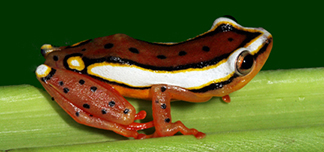| Publication Type: | Journal Article |
| Year of Publication: | 2004 |
| Authors: | S. Hoegg, Vences, M., Brinkmann, H., Meyer, A. |
| Journal: | Molecular Biology & Evolution |
| Volume: | 21 |
| Pagination: | 1188-1200 |
| Date Published: | July |
| Abstract: | Phylogenetic relationships among major clades of anuran amphibians were studied using partial sequences of three nuclear protein coding genes, Rag-1, Rag-2, and rhodopsin in 26 frog species from 18 families. The concatenated nuclear data set comprised 2,616 nucleotides and was complemented by sequences of the mitochondrial 12S and 16S rRNA genes for analyses of evolutionary rates. Separate and combined analyses of the nuclear markers supported the monophyly of modem frogs (Neobatrachia), whereas they did not provide support for the monophyly of archaic frog lineages (Archaeobatrachia), contrary to previous studies based on mitochondrial data. The Neobatrachia contain two well supported clades that correspond to the subfamilies Ranoidea (Hyperoliidae, Mantellidae, Microhylidae, Ranidae, and Rhacophoridae) and Hyloidea (Bufonidae, Hylidae, Leptodactylidae, and Pseudidae). Two other families (Heleophrynidae and Sooglossidae) occupied basal positions and probably represent ancient relicts within the Neobatrachia, which had been less clearly indicated by previous mitochondrial analyses. Branch lengths of archaeobatrachians were consistently shorter in all separate analyses, and nonparametric rate smoothing indicated accelerated substitution rates in neobatrachians. However, relative rate tests confirmed this tendency only for mitochondrial genes. In contrast, nuclear gene sequences from our study and from an additional GenBank survey showed no clear phylogenetic trends in terms of differences in rates of molecular evolution. Maximum likelihood trees based on Rag-1 and using only one neobatrachian and one archaeobatrachian sequence, respectively, even had longer archaeobatrachian branches averaged over all pairwise comparisons. More data are necessary to understand the significance of a possibly general assignation of short branches to basal and species-poor taxa by tree-reconstruction algorithms. |
| URL: | file://localhost/Users/breda/Desktop/Documents/Literature/H/Hoegg.pdf |
